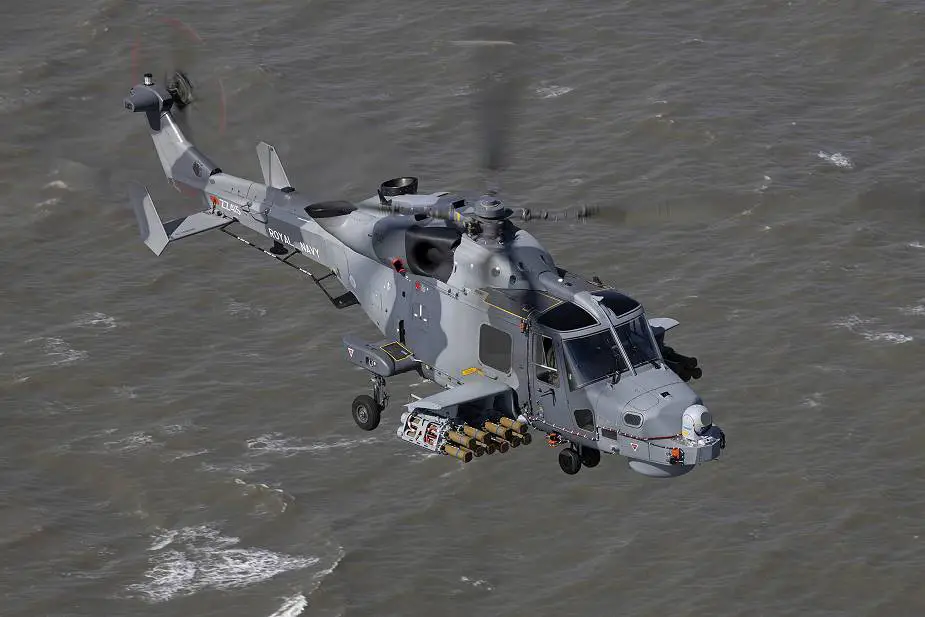Breaking news
British Navy conducts test-fire of new Martlet missile from Wildcat HMA Mk2 helicopter.
British Navy has conducted a firing test of new Martlet missile from Wildcat HMA Mk2 helicopter. The British Royal Navy helicopter crews have proved their ability to protect the UK’s aircraft carriers with a new missile system.
Follow Navy Recognition on Google News at this link
 Martlet missile firing from the British Navy Wildcat helicopter. (Picture source British Navy)
Martlet missile firing from the British Navy Wildcat helicopter. (Picture source British Navy)
The new Martlet missile was fired from a Wildcat helicopter of the British Navy. In 0.3 seconds, the missile detached from the Wildcat HMA Mk2 helicopter, accelerating to one and a half times the speed of sound.
The trials mark an important milestone in the testing of the new system which will arm the Wildcat helicopters that deploy as part of HMS Queen Elizabeth’s maiden operational deployment next year. The Royal Navy and Army introduced Wildcat helicopters into service five years ago and the firing of the Martlet this week is a very significant milestone and represents a huge success for the joint industry and MoD (Ministry of Defense) team.
The Martlet missile, also known as the Lightweight Multirole Missile, has already been successfully launched off frigate HMS Sutherland so the latest firing was to test it in its primary role.
The firing was captured with high-resolution cameras so the teams from both Thales and the Wildcat lead Leonardo Helicopters can analyze the system in minute detail.
The Martlet is a lightweight air-to-surface and surface-to-surface missile developed by Thales Air Defense for the United Kingdom. The British MoD placed an initial order for 1,000 missiles and deliveries due to start in 2013. It can be carried on the new Lynx Wildcat helicopters of the Royal Navy for use against small surface vessels.
The Martlet missile offers a unique capability to defeat asymmetrical and terrorist threats in the littoral environment, such as Fast Inshore Attack Craft (FIAC), RIBs or even jet skis. The precision laser beam riding guidance concept of LMM and the accurate launcher stabilization has been demonstrated for the first time in a UK MoD Sponsored TDP with several firings from a T23 Frigate off the Pembrokeshire coast at an operationally representative remote-controlled FIAC target. It has a weight of 13kg, travels at Mach 1.5, has a range exceeding 6 km, and an immediate launch capability.

A Wildcat helicopter from the British Navy armed with Martlet missiles. (Picture source British Navy)
The Wildcat helicopter is the latest generation of multi-role helicopter specifically procured to operate from the frigates and destroyers of the British Navy. Replacing the Lynx Mk8, the Wildcat has a more powerful engine allowing it to be flown in extreme conditions all year round.
The Wildcat is also equipped with a more robust fuselage, a high tech interactive display, and a new radar system that provides 360-degree surveillance. The Wildcat Maritime Attack Helicopter can carry Sting Ray torpedoes, a door-mounted 0.5" heavy machine gun, and new light and heavy variants of the Future Anti-Surface Guided Weapon Missiles.
Expected to perform a range of tasks, the Wildcat HMA Mk2 will be used in anti-surface warfare, force protection and counter-piracy. It will also be able to carry out an anti-submarine role. As a ship-borne helicopter, Wildcat will provide commanders with a flexible attack capability that can be deployed to tackle a range of threats at sea and from the sea. With state of the art sensors, equipment and weapons, it will be an outstanding asset that will maintain Royal Naval units at the cutting edge of worldwide maritime operations.


























